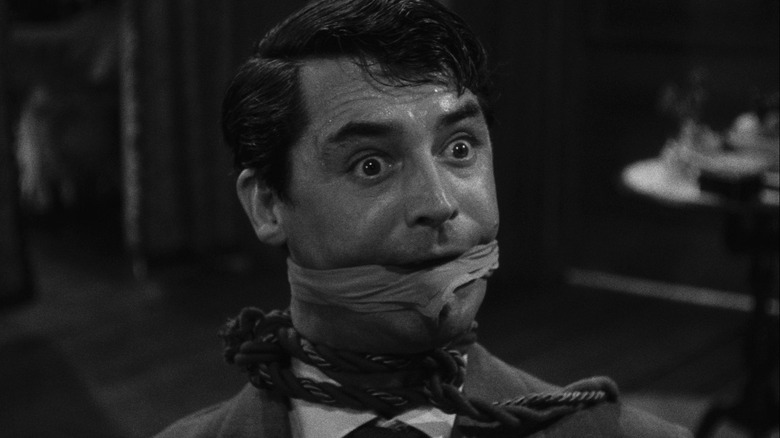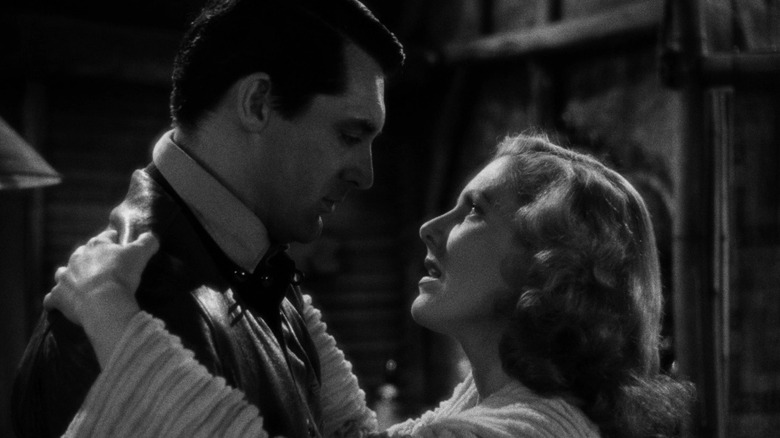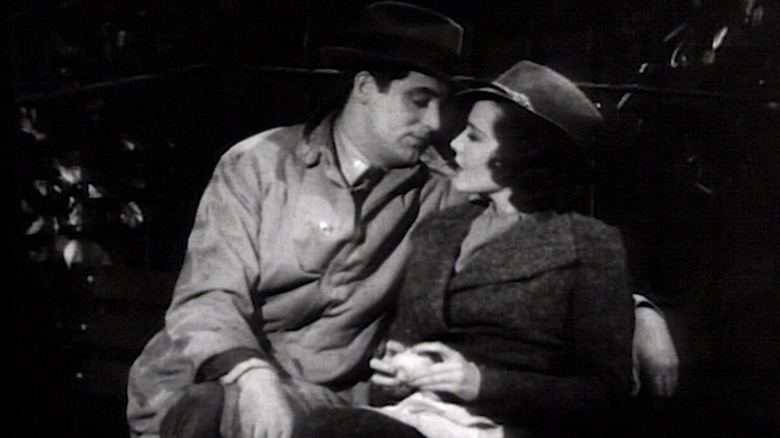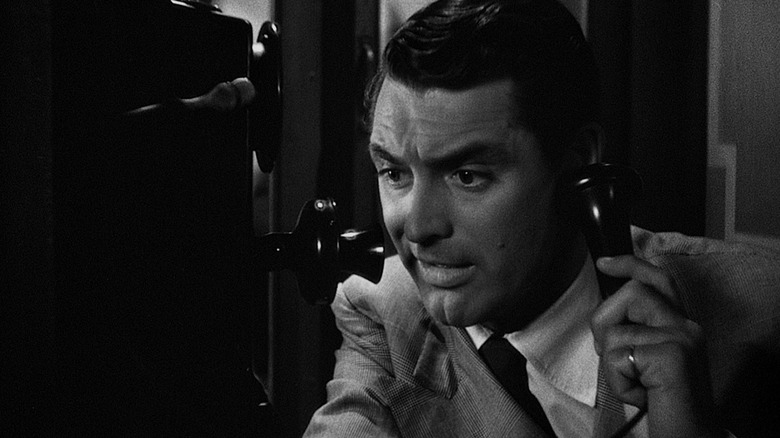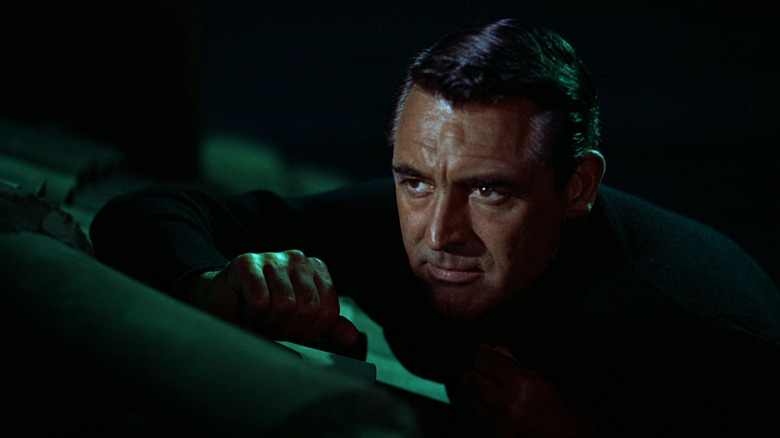Cary Grant Had Two Reasons For Rejecting The Hollywood Contract System
Cary Grant was a one-of-a-kind movie star. Sure, there have been others who have reached his level of fame, acclaim, and stature, but in terms of what made Grant a movie star, there has been no one like him before or since. His ability to seamlessly shift between a Hitchcock noir like "Notorious" to a total goofball comedy like "Monkey Business" remains unparalleled. Add to that his dashing good lucks, tall, athletic frame, and signature mid-Atlantic accent, and you have one of the greatest Hollywood icons of all time, if not the greatest.
For someone with such a distinctly defined movie star persona, his malleability as a performer was rather unusual. In the classic Hollywood era, the major studios were the ones molding stars. They had performers under long-term contracts, allowing them to basically plug in anyone they wished into certain projects. Actors would be paid like regular salaried employees of the studio because that's exactly what they were.
What stands out about Grant is that he was a rare actor of the era who — quite early — eschewed signing a contract with a Hollywood studio, tapping into his traveling nature. While being a freelance actor is how the business has operated for over 50 years now, Grant deciding to go this path was an extremely risky proposition, especially in the 1930s. Even the biggest stars of the period, like Gary Cooper, were at the whim of their employer.
Not so for Grant, who decided to become an independent performer after his contract with Paramount expired in 1936. By going in this direction, Grant was able to get two things that just about anyone would want: the ability to do the work he wants and do it for good money.
Cashing in your chips
Cary Grant's contract with Paramount started in 1931, and according to a biography by Jerry Vermilye, his starting salary was $450 a week, which would increase over time based on performance and stature. By the end of the five years, he was making $3,500 a week. While that would be a great salary for anyone 90 years later today, that wasn't so great when it came to being a major A-list movie star. Concurrently, Gary Cooper was making almost double what Grant was making per week at $6,500. While Cooper was certainly the bigger name at the time, Grant didn't want to be the guy who was simply in the shadow of the bigger star.
By opting for a freelance model, Grant would now get paid by the project instead of by the week. The financial security and stability of the weekly salary are certainly a comfort, but when you are a big enough star to command a bidding war, you will have the studios paying through the nose for your services. Relayed in Vermilye's biography, Grant said of the height of his freelance acting period, "Without a contract, I pushed my money up to $300,000 a picture in no time." If he did two movies at that price in a year, that would essentially double Cooper's annual salary.
The money certainly played a major role in his decision, but it wasn't just that. He also said, "Only Mae West and Marlene Dietrich were permitted to choose their parts at Paramount, and I was fed up with what I was doing." Grant wanted some agency in his creative endeavors.
Playing the roles he wants to play
All an actor really wants to do is play roles they believe are fitting for their talents. A year before his Paramount contract was to end, MGM had their sights on Cary Grant to co-star with Clark Gable and Charles Laughton in their adaptation of "Mutiny on the Bounty." While actors were under contract with one studio, that didn't mean that studios weren't allowed to loan out their actors to other studios for one-off projects if they so desired.
As detailed in a biography by Marc Elliot, Grant was hoping this would be the case, knowing what a golden career opportunity it was. Paramount co-founder Adolph Zukor, however, put the kibosh on the whole enterprise. Ultimately, Franchot Tone was cast in the role, and "Mutiny on the Bounty" won best picture with Laughton, Gable, and Tone all getting nominations in the actor category.
If Grant had complete control over his own career, he wouldn't have been put in that position. He could take the next "Mutiny on the Bounty" or whatever he deemed worthy of spending his time on. Unfortunately, his first foray into freelance acting didn't go so hot, seeing himself head off to his native England to make "The Amazing Adventure of Ernest Bliss." Released in the U.S. as "The Amazing Adventure" and cut down to a lean 62 minutes, the movie was not warmly received and flopped at the box office.
After a failure like that, heading back to Hollywood with his tail between his legs a bit, Grant reconsidered his stance on not signing a Hollywood contract and managed to get one that could make everyone happy.
A contract ... with major stipulations
Was there a way to sign a contract with a studio but still be able to do the films you wanted to and be properly paid for it? Well, Cary Grant pulled a coup and found that middle ground. First, that meant not locking yourself into a studio where your presence could be taken for granted. There were different tiers of studios at the time. The "Big Five" of the era were MGM, Paramount, Warner Bros., 20th Century Fox, and RKO. Then there were the "Little Three," which included Universal, United Artists, and Columbia.
Columbia courted Grant with an extremely appealing offer, according to a biography by Geoffrey Wansell. He would get a four-picture deal with the studio and have script approval on every project. For the first two films, he'd get $50,000 a piece and $75,000 for the last two. Importantly, this contract would also allow him to work at other studios too. Pretty good deal, right? It gets better. He essentially got the same offer from RKO.
This meant that Cary Grant would do one for Columbia, one for RKO, and then one for whoever he pleased. And in every case, he got to choose the project. Not only did this pay off for Grant in a business sense, but the run that he went on is what turned him into the bonafide A+++ lister. For Columbia, he made "The Awful Truth," "Holiday," "Only Angels Have Wings," and "His Girl Friday." For RKO, he had "Bringing Up Baby," "Gunga Din," "My Favorite Wife," and "In Name Only." Plus, he got to go off and make "Topper" and "The Philadelphia Story." All of this is between 1937 and 1940. A true triumph.
Becoming a true free agent
Because his time working with these studios was so successful, Cary Grant just kept doing it after his contracts were up. This method of working was clearly benefitting everyone, and Grant pushed his financial gains even further by actually earning points on the back end. Again, this is something that just about every movie star does now, but at the time, this was unheard of.
The success continued for a little while longer, which included Grant earning his first Oscar nomination for best actor for Columbia's "Penny Serenade" and working with Alfred Hitchcock for the first time on RKO's "Suspicion." But at a certain point in the late 1940s, his star power began waning. If you work by a blueprint for long enough, eventually that blueprint will no longer be accurate.
It's here when Grant really became an independent contractor and worked all over the place — but like his first go at it, things didn't go great. His films made less and less money, quality dipped, and even if he made a really funny movie like "Monkey Business" for Fox, it wasn't seen as such at the moment.
This lackluster period continued until 1955, when he made his first color film with Hitchcock, "To Catch a Thief." Coincidentally, this was his first Paramount film since 1936. The jaunty caper was a big hit and reminded everyone why he was still a one-of-a-kind movie star. For the next decade, as a man in his 50s, he became one of the biggest stars in the world again. By then, a big number of major stars were working freelance, taking their cues from Grant. His method certainly worked for him.
